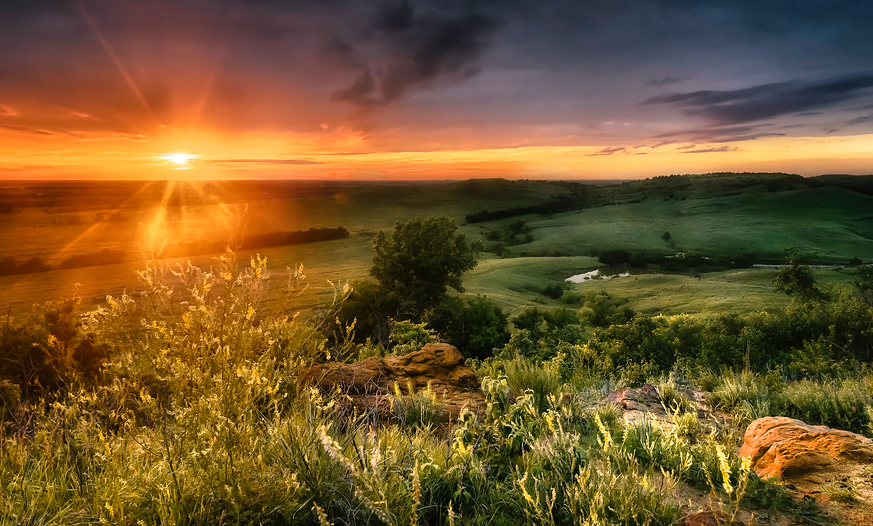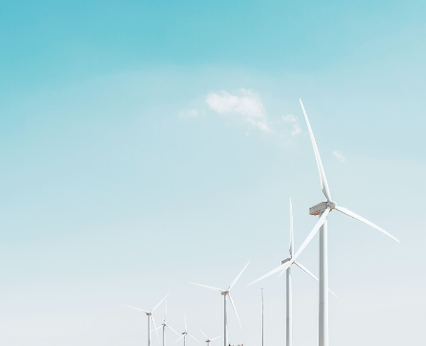To understand Kansas is to understand the power and majesty of the ground we stand on, the water we drink, and the air we breathe. The state’s diverse array of natural resources have sustained generations of Kansans and Indigenous peoples by providing food, shelter, energy, and livelihood. Likewise, admiring the beauty of a sunset over the Flint Hills or hiking through Monument Rocks nourishes and inspires the hearts of outdoorsmen and -women who are proud to make Kansas their home.
This image, captured by Garret Gabriel in 2015, showcases the sweeping vistas found at Coronado Heights Park. The park is located northwest of Lindsborg, KS and is maintained by the Smoky Valley Historical Association.

Oversight and Regulation
The responsibility for ensuring proper stewardship and usage of the state’s natural resources lie primarily with a handful of entities
- Kansas Department of Agriculture
- Kansas Water Office
- Kansas Department of Wildlife and Parks
- Kansas Corporation Commission
- Kansas Department of Health and Environment
Each entity owns a unique piece of the puzzle and manages different aspects of licensure, compliance, regulation, planning, and oversight for their areas of specialization.
Energy

- Wind Farming
- Petroleum
- Natural Gas
- Biofuel
- Solar
- Hydropower
In recent years Kansas has gained attention for the rapid pace at which it has harnessed one of its most powerful, but unseen, resources: wind.
In 2020, Kansas became one of two states where wind overtook coal as the top source of energy production within the state. Over 41% of the state’s net electricity generation is provided by wind power. Kansas is also one of the top 10 ethanol-producing states in the nation. Ethanol relies on both corn and grain sorghum, two robust commodities that also factor heavily in livestock feeding.
When it comes to energy, people usually fall into one of two categories: consumers or producers. Consumers usually interact directly with their local utility company. However, often times consumers have questions or concerns that are best directed to the KCC. Maybe you want to know how utility rates are set or whether it’s safe to dig footers for new fence posts. Another service consumers can take advantage of are utility assistance programs.
Providers are required to meet strict standards for reporting, compliance, safety, and conservation. Specific divisions within the KCC are responsible for providing oversight to the different types of providers, including electric, oil and gas, and pipeline operators. Options exist for both paper-based and online filings/online forms.
Land
Land is infinitely valuable; not only for what can be grown in and on the soil, but also for the fossil fuels and minerals that lie deep within the earth.
Farmers and ranchers are some of the most iconic professions associated with the state of Kansas, and with good reason: There are currently over 45 million acres of farmland and more than 27,000 cattle ranches in operation. In all, agriculture is the top industry in the state, accounting for roughly 40% of the total economy. The Kansas Dept of Agriculture oversees many of the programs related to land usage, including grain farming, dairy production, and animal agriculture.
As noted above, Kansas has recently expanded its production of renewables. However, fossil fuels such as petroleum and natural gas are still natural resources with a significant impact on industry and economy within the state. Hundreds of thousands of oil and natural gas wells have been drilled in the state since the late 19th century. The Kansas Corporation Commission is primarily responsibly for regulating these industries. This includes protecting correlative rights and environmental resources with effective regulatory oversight of oil and natural gas exploration and production activities, and intrastate gas storage.
Not to be overlooked, are the contributions that are made to the state’s economy by our robust network of parks and recreational activities. The Kansas Department of Wildlife and Parks currently manages 28 state parks, 40 state fishing lakes, and 300,000 acres of public lands. These publicly-accessible areas include hiking trails, equestrian trails, swimming beaches, and campgrounds. You can find pictures of many of our beautiful parks and lakes on the Kansas.gov Flickr pool.
The Kansas Biological Survey & Center for Ecological Research is focused on pursuing a deeper understanding of and appreciation for Kansas biological and ecological resources through world-class research, education and service that enlightens, engages and empowers people in our state and beyond. The Natural Resource Planner is an interactive online Kansas map that enables users to choose from and view, separately or simultaneously, more than 20 categories of natural resource and infrastructure data.
Water
The management of water within the state is very complex. Depending on the type of water – groundwater, lakes, rivers, streams, runoff – multiple entities may ultimately be involved, including the federal government.
For example, the Kansas Water Office is charged with developing a vision for the future of water in Kansas; the Kansas Department of Agriculture’s Division of Water Resources manages floodplains and dams, as well as water use reporting and water rights management; Kansas Department of Wildlife and Parks oversees lakes and reservoirs used for recreation, including the issuance of licenses for fishing and boating; and the Kansas Department of Health and Environment includes programs that monitor water quality and safety.
Managing public water and wastewater utilities is largely a function of local government entities, with oversight provided by KDHE’s Bureau of Water. Typically, cities, counties, and rural water districts provide water and wastewater utility services to homes and businesses. The Kansas Rural Water Association provides a broad range of services focused on providing the education and leadership necessary to enhance the effectiveness of Kansas’ water and wastewater utilities. This includes information on rural water rates, city rates, an interactive mapping tool that allows users to determine the boundaries for rural water systems throughout the state and find the contact information for their local provider, a systems directory, and scholarships.
Additional mapping tools for public water supply systems are made available by the Kansas Data Access and Support Center (DASC). The “Water Resources” section of their Data Catalog includes multiple options for viewing water-related data in GIS form. For in-depth information on water rights for specific properties, the Water Information Management and Analysis System (WIMAS) allows users to query, analyze, and map Kansas water rights data.
The following reports, generated by various state entities, provide additional details on the state’s water management reports and plans:
- "Long-Term Vision for the Future of Water Supply in Kansas" - Kansas Water Office, 2015
- "2020 Kansas Integrated Water Quality Assessment" - KDHE Bureau of Water, 2020
- "Dam History in Kansas" - Kansas Department of Agriculture
- "Municipal Water Use in Kansas" - KDA Division of Water Resources, 2017
- Kansas High Plains Aquifer Atlas
- K-State Research and Extension summary of Kansas water law
The Kansas Biological Survey & Center for Ecological Research is focused on pursuing a deeper understanding of and appreciation for Kansas biological and ecological resources through world-class research, education and service that enlightens, engages and empowers people in our state and beyond. The Natural Resource Planner is an interactive online Kansas map that enables users to choose from and view, separately or simultaneously, more than 20 categories of natural resource and infrastructure data.
While the eastern portion of the state receives significantly more precipitation than other regions, the majority of the state’s groundwater is contained within a series of aquifers located beneath the counties to the west/southwest. Of the nine aquifers that exist beneath the state, the High Plains aquifer (which actually runs beneath parts of seven other states) is by far the largest.
Natural lakes are rare in Kansas. As such, Federal reservoirs are an important source of water supply in Kansas, providing water in some manner to roughly two-thirds of Kansas’s citizens. Construction of 24 reservoirs by the federal government spanned from 1940 to 1982. The State of Kansas owns and/or manages conservation storage in 15 federal reservoirs operated by the U.S. Army Corps of Engineers. Depending on individual reservoir characteristics, each has its own specialty.
There are over 10,000 miles of rivers and streams in Kansas. However, most of the waterways within the state are privately-owned. The Kansas, Arkansas, and Missouri rivers are open for public use, except for portions that pass through private land.
Download Resources
Connect With Us
534 S. Kansas Ave., Ste 925
Topeka, KS 66603
© Kansas.gov - Portal Policies


